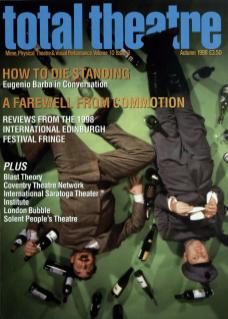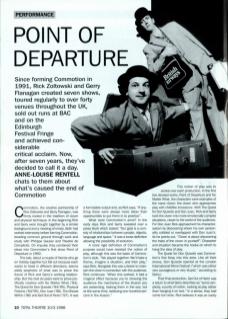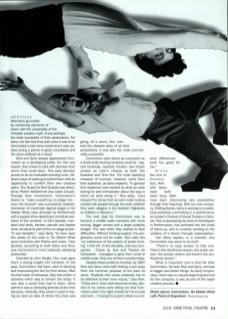Commotion, the creative partnership of Rick Zoltowski and Gerry Flanagan, was firmly rooted in the tradition of clown and physical technique. In the beginning Rick and Gerry were brought together by a similar background and a meeting of minds. Both had worked extensively before forming Commotion, treading common ground through work and study with Philippe Gaulier and Theatre de Complicite. On impulse they combined their ideas into Commotion's first show Point of Departure in 1992.
This tale, about a couple of friends who go on holiday together but fall out because each wants to head in different directions, seems oddly prophetic of what was to prove the future of Rick and Gerry's working relationship. But the next six years were to prove prolifically creative with No Matter What (93), The Quest for Don Quixote (94/95), Physical Fictions (94/95), Don Juan (96), The Ghosts Within (96) and Get Out of Here! (97). It was a formidable output and, as Rick says, ‘If anything there were always more ideas than opportunities to put them into practice.’
What were Commotion's aims? In the early days Rick and Gerry sweated over a press blurb which stated: ‘Our goal is a comedy of relationships between people, objects, language and space.’ It was a loose definition allowing the possibility of evolution.
A more rigid definition of Commotion's purpose would have resisted the notion of play, although this was the basis of Commotion's style. ‘We played together. We'd take a theme, imagine a situation, and then play,’ says Rick. Alongside this was a desire to maintain the clown's connection with the audience. Rick continues: ‘When this worked, it had a magical effect because you're showing the audience the mechanics of the illusion you are presenting, looking them in the eye, but at the same time, believing one hundred percent in the illusion.’
This notion of play was to evolve over each production. In the first two devised works, Point of Departure and No Matter What, the characters were examples of the naive clown: the clown who approaches play with childlike innocence. With The Quest for Don Quixote and Don Juan, Rick and Gerry took the clown into more emotionally complex situations, closer to the world of the audience. For Don Juan Rick approached his characterisation by discovering where his own personality collided or overlapped with Don Juan's. As he points out, ‘Clown is about discovering the traits of the clown in yourself’. Character and situation became the hooks on which to hang the idea of play.
The Quest for Don Quixote was Commotion's first foray into this area. Like all their shows, Don Quixote opened at the London International Mime Festival (‘which was either very courageous or very stupid’, according to Gerry).
Their final production, Get Out of Here! was a return to what Gerry describes as ‘some simplicity, a purity of notion, looking at play rather than hanging it on text’. In a sense, they had come full circle. Rick believes it was an overtly ambitious attempt to go further, by combining elements of clown with the universality of the Christian creation myth. It was perhaps the least successful of their productions. For Gerry, the fact that they both knew it was to be Commotion's last show meant that it was created during a period of great uncertainty and the show suffered as a result.
Rick and Gerry always approached Commotion as a developing entity. For this very reason, they chose to work with directors from whom they could learn. This early decision proved to be an invaluable learning curve. Different ways of working provided them with an opportunity to confirm their own creative paths. The Quest for Don Quixote was directed by Phelim McDermott and Julian Crouch. Through their involvement, Commotion's desire to make everything on-stage live – ‘even the broccoli' – was successfully realised. Animation of inanimate objects began in No Matter What (also directed by McDermott) with a puppet show depicting a miniature evolution of the universe. In Don Quixote, monsters and birds, kitchen utensils and basket work, all became part of the on-stage action. ‘It was fantastic,’ says Gerry, ‘to have seen the seeds of this work in No Matter What come to fruition with Phelim and Julian.’ Don Quixote, according to both Gerry and Rick, was Commotion's most creatively satisfying production.
Directed by John Wright, Don Juan gave them a strong insight into narrative. In the past, Commotion had been used to devising and improvising the text for their shows. After the first week of rehearsal, they had written a scenario which was to remain the script. It was also a script they had to learn. Gerry admits it was a confusing process at the time because, ironically, they weren't used to having so clear an idea of where the show was going. As a result, Don Juan had the clearest story of all their productions. It was also the most commercially successful.
Commotion were about as successful as a small-scale touring company could be – regular bookings, capacity houses, two shows chosen as critic's choices by both The Guardian and Time Out. The most satisfying measure of success, however, came from their audience, as Gerry explains: ‘In general [the audience] were excited by what we were aiming for and enthusiastic about the way in which we were doing it.’ Rick adds, ‘[we] enjoyed the sense that we were really making contact with people through the work, whether they were villagers in the Scottish Highlands or children in Morocco’.
The next step for Commotion was to become a middle-scale company with more touring, bigger venues and a larger publicity budget. This was when they started to face difficulties. Without funding support, the progression could not be made. Rick calls this ‘an indictment of the system of public funding’ in the UK. In two decades, only two companies – Cheek by Jowl and Theatre de Complicite – managed to grow from small to middle-scale. Only one of them survives today.
Despite these problems, however, by 1997 Rick and Gerry were both feeling a pull away from the common purpose of the past six years. ‘Anybody who works creatively has to be attentive to their inner voices,’ says Rick. ‘If they don't, their work becomes empty. Several of my voices were telling me that Commotion wasn't the right context for me to work anymore...it had got to a point where our creative differences were too great for me.’
Since the end of Commotion, Rick and Gerry have both been busy. Both have been discovering new possibilities through their teaching. With his new company, Shifting Sands, Gerry is working on a week-long workshop culminating in a performance at London's Festival of Visual Theatre in October. Rick is developing his work on Archetypes in Performance, has ventured into the world of stand-up, and is currently working on the creation of a sitcom through improvisation.
Can Gerry explain, in a nutshell, why Commotion has come to its end?
‘There's no easy answer to that one. There's the shorthand version, the public version, the private version, and there's the professional version.’
What is important now is that life after Commotion, for both Rick and Gerry, will lead to bigger and better things. As Gerry emphasises, there was no natural beginning and end for the company, it was all part of the larger creative process.


